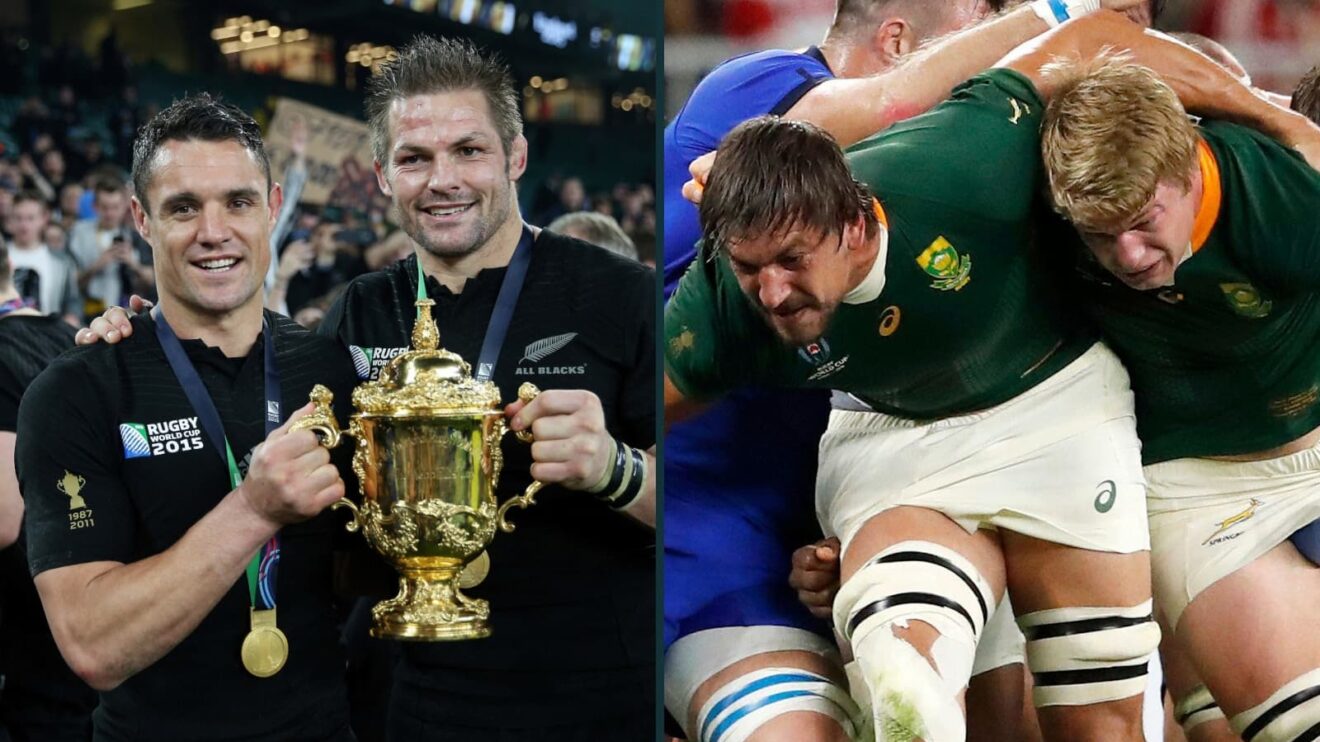All Blacks 2011-2015 and Springboks 2019-23: Our star-studded combined team of Rugby World Cup legends

Dan Carter, Richie McCaw, Eben Etzebeth and Pieter-Steph du Toit make our All Blacks and Springboks Combined Team.
One of the hottest social media debates is which was the greatest dynasty? All Blacks 2011-15 or Springboks 2019-23? It’s a hard call to make, but one that needs to be caveated with the fact that the Boks don’t appear yet to be finished.
However, if you picked a team based upon all four World Cups, what would it look like? We had a go. We’re also sure that you’ll disagree – that’s natural, so leave your teams, thoughts and changes in the comment box below.
Bringing together two generations of world champions demands clarity of thought and respect for what made each side exceptional.
The All Blacks of 2011 and 2015 were defined by precision and continuity, their game built on speed of execution and an ability to sustain pressure without sacrificing control. The Springboks of 2019 and 2023 imposed themselves through power, tactical discipline, and defensive resilience that turned contests into battles of attrition.
The goal is not to dilute these qualities but to create a team that expresses both identities in harmony – here’s our best shot.
Front-row
The foundation begins with Tendai Mtawarira, whose performance in Yokohama remains one of the most dominant scrummaging displays in World Cup history. His technique and strength make him the natural choice at loosehead. Malcolm Marx takes the hooker role, combining set-piece authority with breakdown aggression that shifts momentum at critical moments. At tighthead, Frans Malherbe provides the stability and control that allows this front-row to dictate terms against any opposition – in fact, it’s an all-Bok trio, which says everything about their power game – and yes, it was ridiculously hard to leave out Ox Nche, which shows the level we’re selecting at.
Locks
Eben Etzebeth brings physicality and presence that few can match, whilst Brodie Retallick offers athleticism and skill that elevate the second-row beyond its traditional role. Together they deliver a blend of force and mobility that underpins both set-piece and open play. Maybe harsh on Sam Whitelock and Lood de Jager, but we see this has real balance.
Back-row
Pieter-Steph du Toit occupies the blindside position, his defensive range and relentless work rate complementing Richie McCaw at seven, whose influence at the breakdown and ability to shape momentum remain unmatched. The mercurial Kieran Read completes the trio at eight, just easing out Duane Vermeulen with a slightly more rounded game, providing aerial security, distribution, and the timing that turns loose ball into structured attack. A word for Jerome Kaino – the hardest decision we had to make, but no-one can argue with PSDT’s contribution.
Half-backs
Aaron Smith directs the game from nine with a pass that accelerates attacking shape before defences can adjust. Outside him, Dan Carter controls territory and tempo with a skill set that defines the modern fly-half. Their partnership ensures clarity in every phase and it was the easiest of all of our unites to pick.
Midfield
Ma’a Nonu at 12 offers power and subtlety in equal measure, while Conrad Smith at 13 brings defensive organisation and decision-making that few have ever matched. This combination secures the gainline and opens space for the strike runners outside – and we admit we went for the tried and trusted combination here – unfortunate for the brilliant Lukhanyo Am who just misses out.
Back three
The left wing belongs to Makazole Mapimpi, whose finishing instincts and work rate have become hallmarks of South Africa’s modern game. His ability to track play and convert half-chances into points makes him indispensable in a system that values precision under pressure. On the opposite flank, Cheslin Kolbe brings agility and footwork that fracture defensive lines, creating opportunities where none seem to exist, still giving Owen Farrell nightmares every evening. At full-back, Ben Smith provides the most complete skill set of his generation. His positional awareness and aerial dominance secure the backfield, whilst his counter-attacking decisions consistently turn defence into structured attack.
Impact subs
Impact comes from double world champion and final try scorer, Tony Woodcock with Vincent Koch alongside him in the front-row, and Keven Mealamu offering dynamism at hooker. Whitelock covers lock, Vermeulen adds power and breakdown strength, and Kwagga Smith injects energy and versatility – fast becoming the Oppenheimer of Bomb Squads. Faf de Klerk provides tempo and defensive bite at nine, whilst the Bok talisman, Handré Pollard, offers composure and a kicking game that closes out contests.
Combined team
Starting XV: 15 Ben Smith, 14 Cheslin Kolbe, 13 Conrad Smith, 12 Ma’a Nonu, 11 Makazole Mapimpi, 10 Dan Carter, 9 Aaron Smith, 8 Kieran Read, 7 Richie McCaw, 6 Pieter-Steph du Toit, 5 Brodie Retallick, 4 Eben Etzebeth, 3 Frans Malherbe, 2 Malcolm Marx, 1 Tendai Mtawarira
Replacements: 16 Keven Mealamu, 17 Tony Woodcock, 18 Vincent Koch, 19 Sam Whitelock, 20 Duane Vermeulen, 21 Kwagga Smith, 22 Faf de Klerk, 23 Handré Pollard